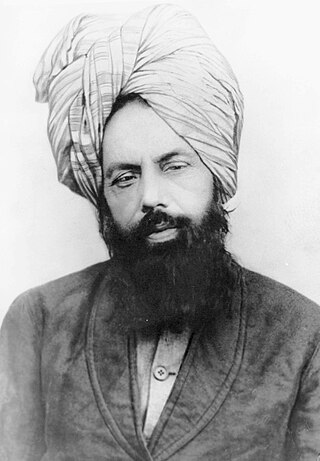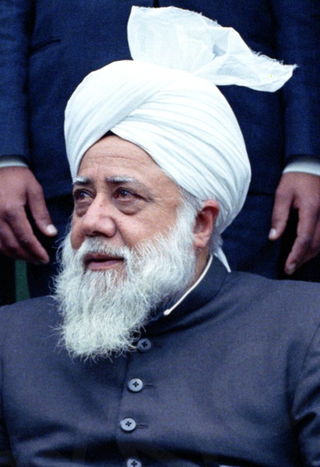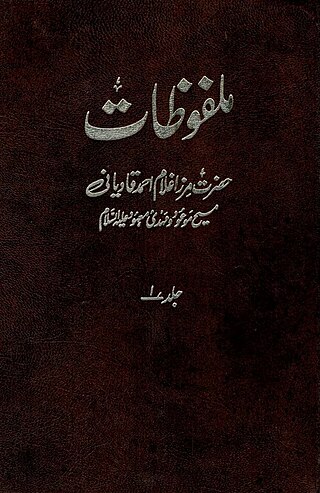| |||||
| Decades: | |||||
|---|---|---|---|---|---|
| See also: | |||||
Events from the year 1974 in Pakistan.
| |||||
| Decades: | |||||
|---|---|---|---|---|---|
| See also: | |||||
Events from the year 1974 in Pakistan.
Qadiani or Qadiyani is a religious slur used to refer to Ahmadi Muslims, primarily in Pakistan. The term originates from Qadian, a small town in northern India, the birthplace of Mirza Ghulam Ahmad, the founder of the Ahmadiyya movement. While it is pejorative to the Ahmadiyya Muslim Community, it is used in official Pakistani documents.

MirzāGhulām Aḥmad was an Indian religious leader and the founder of the Ahmadiyya Movement in Islam. He claimed to have been divinely appointed as the promised Messiah and Mahdī—which is the metaphorical second-coming of Jesus (mathīl-iʿIsā), in fulfillment of the Islamic prophecies regarding the end times, as well as the Mujaddid of the 14th Islamic century.

The Lahore Ahmadiyya Movement for the Propagation of Islam, is a separatist group within the Ahmadiyya movement that formed in 1914 as a result of ideological and administrative differences following the demise of Hakim Nur-ud-Din, the first Caliph after Mirza Ghulam Ahmad. Members of the Lahore Ahmadiyya movement are referred to by the majority group as ghayr mubāyi'īn and are also known colloquially as Lahori Ahmadis.
Anti-Ahmadi activities grew stronger and General Zia's government also took part in it. Ordinance XX was passed, which practically criminalized the Ahmadiyya faith. As a result, Mirza Tahir Ahmad had to migrate to England.

Mirza Nasir Ahmad was the third Caliph of the Ahmadiyya Muslim Community. He was elected as the third successor of Mirza Ghulam Ahmad on 8 November 1965, the day after the death of his predecessor and father, Mirza Basheer-ud-Din Mahmood Ahmad.

Mirza Basheer-ud-Din Mahmood Ahmad was the second caliph, leader of the worldwide Ahmadiyya Muslim Community and the eldest son of Mirza Ghulam Ahmad from his second wife, Nusrat Jahan Begum. He was elected as the second successor of Mirza Ghulam Ahmad on 14 March 1914 at the age of 25, the day after the death of his predecessor Hakim Nur-ud-Din.

Malfūzāt is a ten-volume collection of the discourses, question-and-answer-sessions, sermons and dialogues of Mirza Ghulam Ahmad, the founder of the Ahmadiyya movement. The volumes contain, for the most part, speech that was transcribed by several of Ghulam Ahmad's close disciples as it was being communicated and was published in Ahmadi periodicals during his lifetime, covering a period starting from 1891 until his death in 1908. This material was compiled and published as a set of volumes during the 1960s.

The Ahmadiyya branch of Islam has been subjected to various forms of religious persecution and discrimination since the movement's inception in 1889. The Ahmadiyya Muslim movement emerged within the Sunni tradition of Islam and its adherents believe in all of the five pillars and all of the articles of faith required of Muslims. Ahmadis are considered non-Muslims by many mainstream Muslims since they consider Mirza Ghulam Ahmad, the founder of the movement, to be the promised Mahdi and Messiah awaited by the Muslims.

Ahmadiyya, officially the Ahmadiyya Muslim Community or the Ahmadiyya Muslim Jama'at, is an Islamic revival or messianic movement originating in Punjab, British India, in the late 19th century. It was founded by Mirza Ghulam Ahmad (1835–1908), who claimed to have been divinely appointed as both the Promised Mahdi and Messiah expected by Muslims to appear towards the end times and bring about, by peaceful means, the final triumph of Islam; as well as to embody, in this capacity, the expected eschatological figure of other major religious traditions. Adherents of the Ahmadiyya—a term adopted expressly in reference to Muhammad's alternative name Aḥmad—are known as Ahmadi Muslims or simply Ahmadis.

The Lahore riots of 1953 were a series of violent riots against the Ahmadiyya Movement, a faith marginalized in Pakistan, mainly in the city of Lahore, Pakistan as well as the rest of Punjab, which were eventually quelled by the Pakistan Army who declared three months of martial law. The demonstrations began in February 1953, soon escalating into citywide incidents, including looting, arson and the murder of somewhere between 200 and 2000 people, while thousands more were left displaced. According to the official inquiry conducted by the Punjab Government the actual number killed in these riots were around 20 people. The page one of the inquiry says "Before the declaration of Martial Law, the police had to resort to firing in several places and at least two persons were killed on the night of 4th March and ten on 5th March, Sixty-six persons more must have been injured in the firing because that number of wounded persons admitted to the Lahore hospitals had gunshot wounds. The number of casualties admitted by the military to have been caused in quelling the disturbances in Lahore was eleven killed and forty-nine wounded. In some other towns also there were a number of casualties caused by firing by the police or the military.". Official Unable to contain the increasingly widespread civil disorder, Governor-General Ghulam Muhammad handed over the administration of the city to the army under Lieutenant General Azam Khan, imposing martial law on 6 March.

The 2005 Mong shooting occurred on 7 October 2005 in Mong in the Mandi Bahauddin District, Punjab, Pakistan. Eight members of the minority Ahmadiyya Muslim Community were killed inside a mosque as worshipers were performing Salat.

Majlis-e Ahrar-e Islam, also known in short as Ahrar, is a religious Muslim political party in the Indian subcontinent that was formed during the British Raj on 29 December 1929 at Lahore.

Ahmadiyya in Pakistan are members of the Ahmadiyya Community. The number of Ahmadiyya in the country has been variously estimated to between 0.22% and 2.2% of Pakistan's population. Hence, Pakistan is the home to the largest population of Ahmadis in the world. The city of Rabwah in the province of Punjab used to be the global headquarters of the Ahmadiyya Community before they were moved to England.
From late May to early September 1974, Ahmadi in Pakistan were victim to riots involving killing, torture, looting, robbery, and burning. Attacks took place around the country in Islamabad, Peshawar, Hafizabad, Gujranwala, Lala Musa, Jhang, Wah Cantt, Burewala, and other localities in Pakistan. 20 Ahmadi individuals were reported killed and Ahmadi mosques were demolished, burned, and closed by authorities. Authorities reacted not by acting against the rioters but by passing an amendment to the constitution defining Ahmadis as 'non-Muslim'.

Ahmadiyya is an Islamic religious movement originating in 1889 in northern India around the teachings of Mirza Ghulam Ahmad (1835–1908), who claimed to have been divinely appointed as both the promised Mahdi and Messiah expected by Muslims to appear towards the end times.
Majlis-e-Tahaffuz-e-Khatme Nabuwwat is the programmatic name of a Pakistani Barelvi organization and Islamic religious movement in Pakistan aiming to protect the belief in the finality of prophethood of Muhammad based on their concept of Khatam an-Nabiyyin. It was founded by Mohammad Abdul Ghafoor Hazarvi in 1950 with Zafar Ali Khan, Abdul Hamid Qadri Badayuni, Khwaja Qamar ul Din Sialvi, Syed Faiz-ul Hassan Shah, Ahmad Saeed Kazmi, Abdul Sattar Khan Niazi, Pir of Manki Sharif Amin ul-Hasanat, Muhammad Karam Shah al-Azhari, Sardar Ahmad Qadri and Muhammad Hussain Naeemi. Later on the prominent Barelvi leaders Shah Ahmad Noorani, Shaikh ul Quran Allama Ghulam Ali Okarvi, Pir Muhammad Alauddin Siddiqui, Muhammad Shafee Okarvi, Syed Shujaat Ali Qadri, Iftikharul Hasan Shah and Khalid Hasan Shah also joined them to oppose the Ahmadiyya Movement.

Ahmadiyya in The Gambia is part of the worldwide Ahmadiyya Muslim Jama'at under the leadership of the Ahmadiyya Caliphate. Ahmadiyya teachings entered Gambia during the era of the Second Caliphate through the flow of Ahmadiyya literature and a number of traders returning to the country. The first missionary to enter the country was Alhaji Hamza Sanyaolo, a Nigerian who entered in 1959. After a number of months he was followed by Gibriel Saeed, a Ghanaian missionary. Since its earliest history in the Gambia, the community has been facing resistance and religious intolerance from certain Muslim clerics and Islamic bodies in the country.

Ahmadiyya is an Islamic community in Afghanistan, under the leadership of the caliph in London. The earliest contact with the Ahmadiyya movement in Islam and the Pashtun people within modern-day boundaries of Afghanistan, occurred during the lifetime of Mirza Ghulam Ahmad. The movement began by Ahmad, was largely seen as apostasy by most other Muslim groups, including by those in Afghanistan, and accordingly only twelve years after Ahmad's claim to be the promised Mahdi, two of the foremost Ahmadi Muslims were stoned to death in Kabul during 1901 to 1903. The killings continued until 1925, when in 1924–1925, under Emir Amanullah Khan, affiliation with Ahmadiyya beliefs became a capital offence and those who converted were forcibly reverted.

Ahmadiyya is an Islamic movement in Australia, first formally founded in the country in the 1980s, during the era of the fourth caliph. However, the history of the Community dates back to the early 20th century, during the lifetime of the founder of the movement, Mirza Ghulam Ahmad, with the first contacts arising as a consequence of Australians travelling to British India, and also as a consequence of early, "Afghan" camel drivers settling in Australia during the mid to late 19th century. Today there are at least four Ahmadi mosques in four of the six Australian states, representing an estimated 6,000-8,000 Australian Ahmadis in the country.